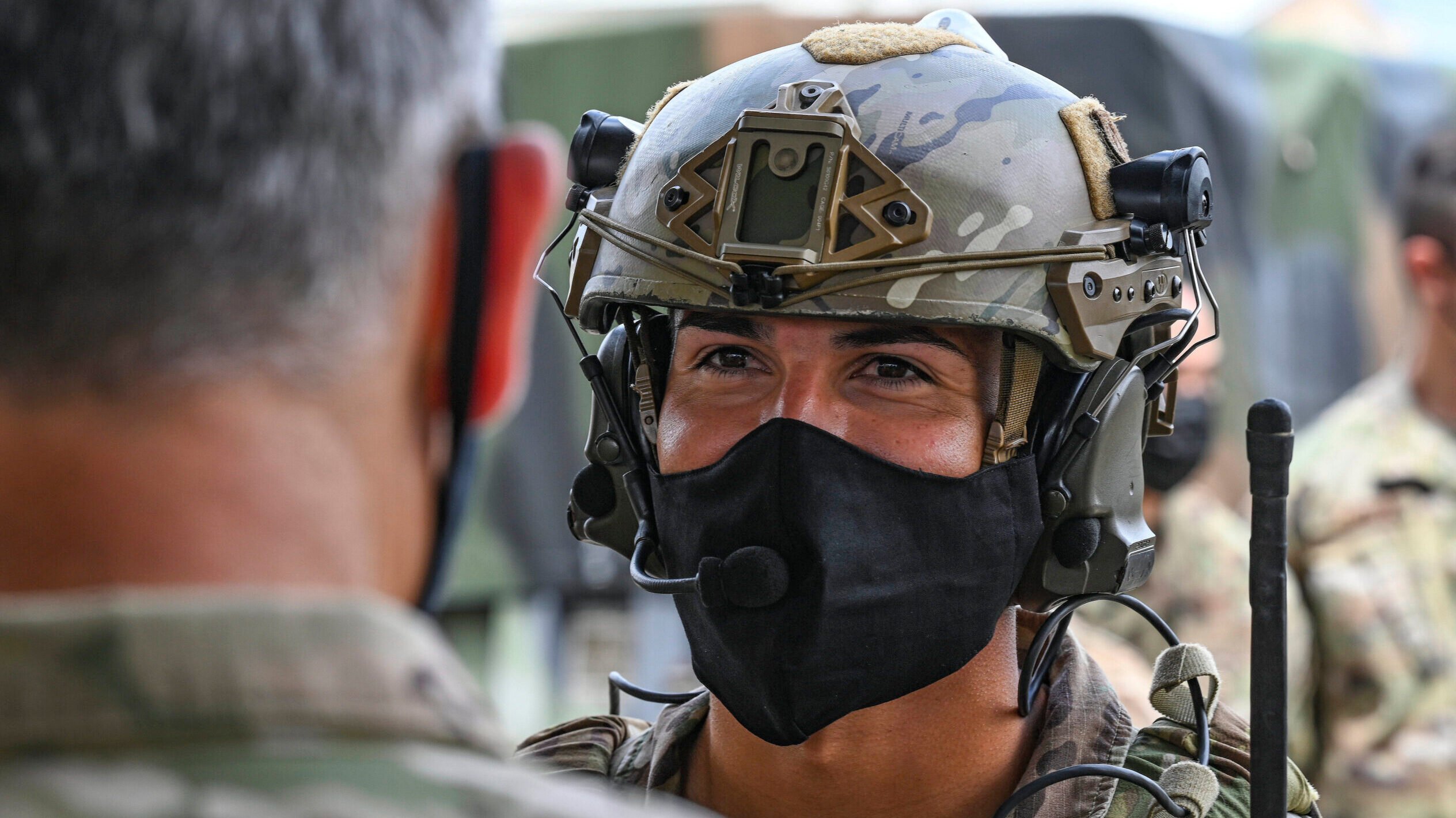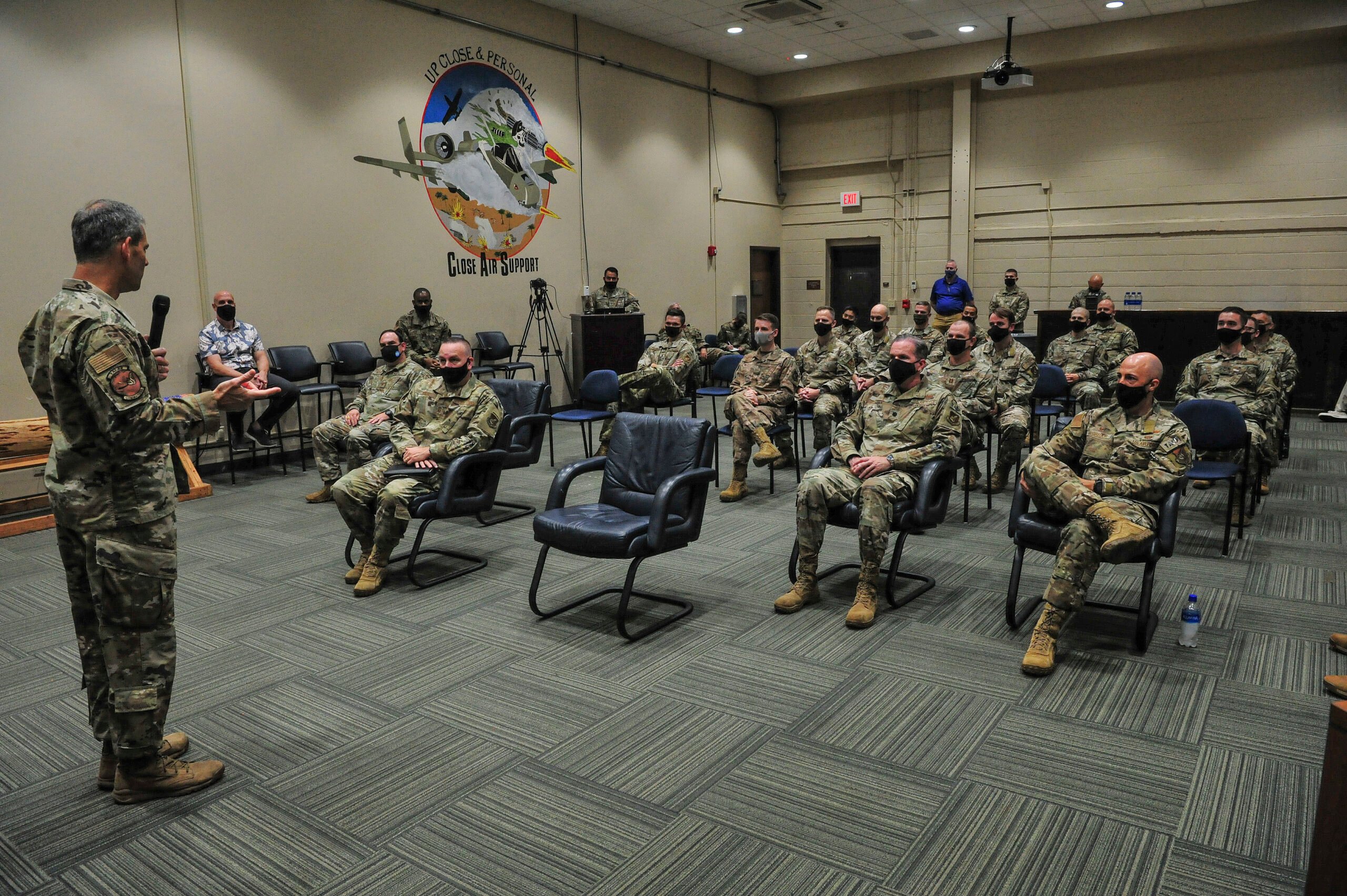
U.S. Air Force Staff Sgt. Jacob Lara, 25th Air Support Operations Squadron joint terminal attack controller instructor, smiles underneath his mask during a conversation with U.S. Air Force Gen. Ken Wilsbach, Pacific Air Forces commander at Wheeler Army Air Field, Hawaii, April 23, 2021. (U.S. Air Force/ Tech. Sgt. Nick Wilson)
In his paper entitled “Multi-Domain Operations in Context” published by the Association of the United States Army (AUSA) in 2020, William “Scott” Wallace, a retired four-star officer and former commander of US Army Training and Doctrine Command, identified why MDO and Joint All Domain Command and Control (JADC2) are far from “pre-ordained” and must evolve from a sensor-to-shooter targeting philosophy to a command-and-control philosophy
In this discussion, Wallace addresses realities of what it means to be part of a Great Power competition and where he sees deficiencies in US response to adversary actions. Wallace, a member of the AeroVironment Strategic Advisory Group, also talks about the role of unmanned systems in multi-domain operations (MDO).
Breaking Defense: In your MDO report published by AUSA, you wrote that the US might be “deficient” in addressing sophisticated counter capabilities developed by China and Russia. What might those counter capabilities look like and how should the DoD respond?

Gen. (ret.) Scott Wallace, former commander, US Army Training and Doctrine Command. (Photo Courtesy of Scott Wallace)
Wallace: At a very high level it is entirely logical that our potential adversaries have gone to school on the American way of war, the Western way of war, and probably have identified some areas where we are either overly dependent or deficient, specifically in the area of networks.
With regard to how we get to the fight in the first place, our paradigm has been to deploy somewhere, build up a logistics space, and bring in our allies. Once you have a foothold in a theater of operations, it’s very difficult to defeat the US and its allies.
Our potential adversaries, principally China and Russia, have looked at the way we go to the fight and said, “if they’re that dependent on the network, how do we deny them use of the network?” In response, they have developed ground- and space-based capabilities to at least diminish the availability of the network and perhaps its utility.
Not that they can completely turn off the network all the time for all forces, because I think that’s probably beyond their capabilities – and ours, by the way – but, given a specific requirement, they can probably do some very sophisticated jamming and we’ve got to learn to be able to expect it, counter it, and fight through it when it does happen.
The second area is the issue of anti access and area denial (A2/AD), which both Russia and China have invested in to counter our ability to even get to the fight. In the Pacific, China is militarizing as part of its island-chain strategy. It is very sophisticated, and the air-and-missile-defense programs and capabilities that both China and Russia possess are other means of denying us access to an area of operations.
We don’t like to talk about this frequently, but what if we began deploying from Fort Hood, TX, to the port of Beaumont and somebody attacked the electronic infrastructure that is required to operate train systems and ports? It denies us the ability to get out of the starting blocks.
That is something that we first of all have to recognize is out there. Secondly, we have to take steps to strengthen our infrastructure to the extent we can. And thirdly, we need to look for means by which we could work around either partial or total denial. That’s true at the tactical, operational, and strategic levels.
Breaking Defense: That’s interesting. I just read that pro-democracy Ukrainian hackers have tried to disrupt railroad lines in Belarus to prevent Russia from moving troops and materiel through Belarus to the Ukrainian border.
Wallace: We shouldn’t be surprised by it, because it’s going on there and it was part of the campaign in the Crimea. There are plenty of contemporary examples of those kinds of capabilities being deployed on both sides of the line of scrimmage.
Breaking Defense: JADC2 relies on all the services sharing data in an OODA (observe–orient–decide–act) loop extended through space, air, ground, sea, and cyber. Lessons of the past seem to make the possibility of JADC2 a pipe dream except in the most limited of ways — certainly in the near term. Do you agree with that assessment and what can be done about it?
Wallace: I think we can, the question is whether we will. And the will question is the more important of the two. I think there are cultural barriers between the services that need to be addressed and broken down for it to work. It is dependent upon (development) of a ubiquitous network that is defendable, resilient, and multi-path. That’s going to be hard. I don’t think it’s a pipe dream, but I do think it’s a way off. And the way off is defined by how culturally the services will accept, in some cases, the delegation of their capabilities in support of another services’ capability. Because that’s what we’re really talking about.
The second thing about JADC2, and now I’m putting on my Army hat, is that JADC2, at least in its infancy, talks all about sensors and shooters. It’s almost like a targeting philosophy rather than a command-and-control philosophy.
Putting myself intellectually in the role of the commander, how does a commander influence execution of operations in a JADC2 environment where you have sensor data being moved all over the battlefield that you really can’t influence because it happens a lot quicker than you can think? And how does a commander exercise mission-command-type direction to his forces in an environment that is moving that quickly?
I don’t have an answer to that, but it does concern me to some extent. The acronym (JADC2) is Joint All-Domain Command and Control. But the sensor-to-shooter targeting element is what we have been focusing on, as well as the command and control of sensors and shooters. The command and control of organizations and formations within a theater context in my judgment is lacking.
Or it may be that I’m culturally biased because I’m a former soldier. But the mission-command aspect of Joint All-Domain Command and Control is something that I just haven’t seen a lot of and I think is absent, perhaps, from some of our thinking. Maybe it will evolve once we have a solution to this ubiquitous network requirement, which I believe is part of JADC2, but there’s very little discussion that I have seen about the mission command aspects that are necessary, in my judgment, for theater-level operational and tactical command.

U.S. Air Force Gen. Ken Wilsbach speaks to Airmen from the 25th Air Support Operations Squadron at Wheeler Army Airfield, Hawaii, April 23, 2021. Wilsbach had the opportunity to engage tactical warfighting Airmen, highlight the importance of what they bring to the fight, and articulate how it contributes to a free and open Indo-Pacific. (U.S. Air Force photo by Tech. Sgt. Nick Wilson)
Breaking Defense: Let’s talk about the use of unmanned aircraft systems (UAS) for multi-domain operations). Earlier you mentioned A2/AD. During the Afghanistan and Iraq wars, the US operated UAS with full impunity. That won’t be the case against China/Russia during a Great Power competition. What role will tactical unmanned systems, both aerial and ground, play in such a scenario against adversaries with A2/AD capabilities?
Wallace: First, if you assume that you’ve got an A2/AD problem, and if you don’t want to throw manned systems at the problem, then unmanned systems make an eminent amount of sense.
The other thing relative to unmanned systems is the use of lethal and non-lethal means in order to attack an enemy’s capabilities and gain some advantage. It’s important to understand that lethality is simply the destructive power of the munition. It’s the terminal result of a chain of events. It’s a process that includes gathering information, positioning of the lethal means, and making decisions about their use. To the extent that you can put that entire process into an unmanned system is something that gives you incredible advantage.
Take, for example, a loitering munition. In the hands of a trained operator, the loitering munition can gather information and be positioned at the place where you want it on the battlefield. The operator can make decisions about whether it’s the appropriate target or not, and then make decisions about attacking or not attacking that particular target.
That can be done all in one package rather than needing an organization that does information gathering, an organization that maneuvers, and an organization that does the actual lethal or non-lethal strike. It collapses that OODA loop into one very small package, which makes it much more flexible and capable and reduces dependence upon higher-level communications to execute the mission.
The same is true for unmanned ground systems, which could be used at scale to begin to eliminate the enemy’s anti-access area-denial capabilities and to allow maneuver forces and air forces to jointly attack the enemy’s formations and begin to reduce their capability to execute and therefore gain an upper hand.
I can imagine sometime in the not too distant future, a munition that is circling overhead that has embedded in it some kind of artificial intelligence associated with target recognition. That munition is not programmed to go after tanks and trucks, but can discriminate against an air defense system or, for that matter, a command post.
Taking out a single tank in a formation does not have a great deal of impact. It pisses off the tank crew and it makes his buddies very apprehensive, but it doesn’t have a substantial impact on the overall formation. But if you take out a command post or something the enemy has in small numbers, that is essential to their ability to prosecute a fight, then that begins to have an impact on the enemy’s capability.
I remember when I was assigned to the National Training Center, the OPFOR (opposing force) at the NTC used to have a saying, and I don’t know if they do it anymore, but they said, “attack things on the battlefield that look goofy” because goofy looking things usually have a specific task and purpose like an ABLB (armored vehicle launched bridge). If the enemy only has four or five of them and you take away all of them, then their ability to do gap crossing is eliminated.




















